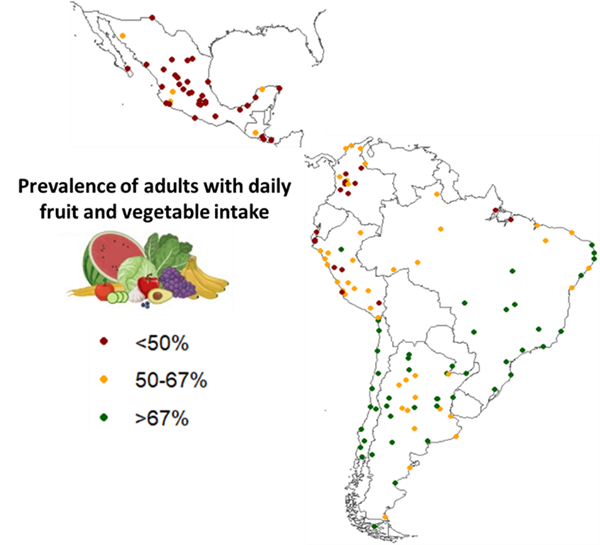Fruit and Vegetable Intake in Latin American Cities: Exploring Contextual Factors for a Healthier Future
Posted on
April 2, 2025
By Giovanna Valentino Peirano. Doctoral Student, School of Public Health, University of Chile,
In Latin American cities, less than 10% of the adult population meets the daily fruit and vegetable recommendation of “5 a day”. Although food choices depend on individual socioeconomic status and vary according to age and gender, contextual variables also play a significant role. A recent ecological SALURBAL study estimated the prevalence of daily fruit and vegetable intake in 144 cities across eight Latin American countries: Argentina, Brazil, Chile, Colombia, Mexico, Peru, Guatemala, and El Salvador; and explored patterns according to urban contextual factors. Cities with higher socioeconomic development, women´s empowerment, lower gender inequality and with temperate climate zones had the highest proportion of their adult population consuming fruits and vegetables daily. The findings bring valuable insight into urban health challenges and offer a foundation for local diagnosis and targeted solutions.
Why Fruits and Vegetables are Important?
Fruits and vegetables are the main sources of vitamins, minerals, polyphenols and other bioactive compounds that have antioxidant activity. A diet rich in fruits and vegetables is critical for maintaining health and preventing most chronic diseases such as hypertension, high cholesterol and diabetes. Therefore, their intake reduces the risk for total mortality, cardiovascular diseases and some cancers.
Patterns Observed in Latin American Cities

Figure 1. Prevalences of daily fruit and vegetable intake for 144 Latin American cities. AR, Argentina, BR, Brazil, CL, Chile, CO, Colombia, GT, Guatemala, MX, Mexico, PE, Peru, SV, El Salvador.
Across Latin America, vast disparities exist in the intake of fruits and vegetables. Although a country pattern was evident in the ecological study, with Southern Cone cities (South Brazil, Chile, and Argentina) showing higher prevalences for daily intake, the prevalences showed a wide range across cities, from 22.1% to 85.4%. High variability was also evident within most of the countries.
As expected, wealthier cities (higher GDP per capita) with higher labor force participation showed higher prevalences of daily intake, which are explained by greater availability and economic access to food. Lower-income groups are especially vulnerable, as barriers like cost and accessibility prevent regular consumption of fruits and vegetables.
Women’s Empowerment

Women´s empowerment is defined as the power of women to make decisions about their own lives. Cities with higher women´s empowerment, conceptualized by female labor force participation and low proportion of early marriage, showed higher prevalences for daily intake of fruit and vegetables. This is not surprising: Empowered women often have more resources to access fresh foods and prioritize nutrition within their communities. The results also reflect that although women show advances in autonomy, household chores still rely mainly on women. In Latin America, women spend twice the time compared to men on unpaid domestic chores.
Climate Zones: Link to Local Availability
Latin America’s diverse climate zones play a significant role in the availability of foods and dietary disparities. Urban areas in tropical and temperate regions typically enjoy greater availability of fruits and vegetables due to favorable conditions for growing them. On the other hand, cities in extremely cold or arid climates face challenges related to food production and distribution. Cities with temperate weather had higher prevalences of fruit and vegetable daily intake, but tropical regions did not show this trend. These differences can occur because lower temperatures and humidity observed in temperate climates maintain better the quality of fruits and vegetables during post-harvest storage, transport and retail, preventing losses and favoring access. These climate-related differences mean some cities have natural advantages in promoting healthy eating, while others rely heavily on costly supply chains. Urban planners and policymakers must consider how climate interacts with food systems—and invest in solutions like adequate transport and storage infrastructure (controlled temperature and humidity), urban agriculture, and climate-resilient farming practices.
Barriers to Healthy Diets in Urban Population: What can be done?

Graphical Abstract
The interplay between socioeconomic context, women’s empowerment, and climate zones creates a complex web of barriers to urban nutrition. Addressing these challenges requires multi-faceted approaches. Barriers like cost, access, and empowerment do not depend just on individual choices; they rely on systemic change. Cities that invest in innovative policies and community-driven solutions can create healthier environments for future generations.